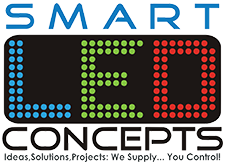Stand Apart with Stadium LED Screens in your Restaurant
The is no room for average or ordinary in the hospitality industry anymore. Customer engagement is key to building your brand and running a successful business. What worked yesterday will not work tomorrow. At Smart LED Concepts we are hyper-aware of this, that is why we continue to create new and better ways to give your customers a unique experience.
If you wait until the end of the video above you will see Julian stand beside the screen to give some perspective to the size of the wall mount.
Think Big
Go big or go home, this applies to your restaurant and bar as well. LED screens are becoming more popular simply because they work at attracting and maintaining customer attention. Customers will retain messages on LED screens up to 10 times longer than other forms of message communication out there.
Understanding LED Screens
NITS Explained
What does NIT mean when referring to LED screens – simply put the industry has settled on a standard that helps to discuss and compare LED signs and they call it a nit. Also referred to as “candelas per square meter” a nit is a unit of measurement for the total brightness over one square meter of an LED display. The value takes into account all of the contributing factors to brightness, such as the number of LEDs per pixel, the pixel pitch (link to explain) and the brightness of the individual pixels.
The nit measurement is different than the measurements of other light sources such as projectors and flashlights, they are measured in lumens. There is a very good reason for this as the light source gets further from the projected surface the light per square meter decreases; it, therefore, loses a lot of brightness and clarity.
With LED screens the light is projected outwards towards your eyes and is not absorbed by a secondary surface and this is why the nit count is important. For outdoor screens, the nit count is typically between 5000 and 8000 nits (Digital Marketing US screens have a nit count of 7000) as a comparison typical televisions range from 500 to 1000 nits and indoor LED signs from 1000 to 2000 nits.
Now we understand the basics of nits in the context of brightness to our screens let’s look to why it is important. With our outdoor screens the display is competing with the sun – it not only competes with the brightness but also the duration of sunlight. The brighter the display the better able it is to compete with the sun.




